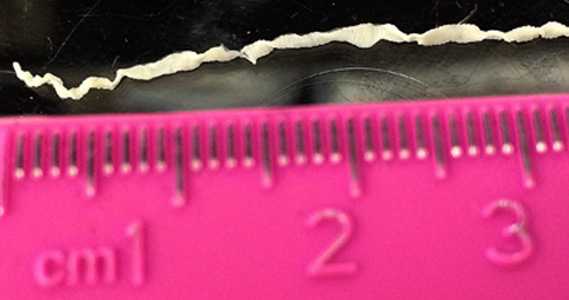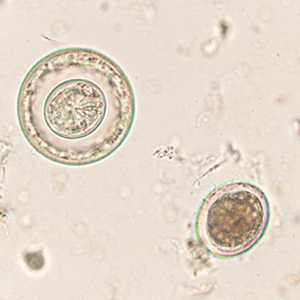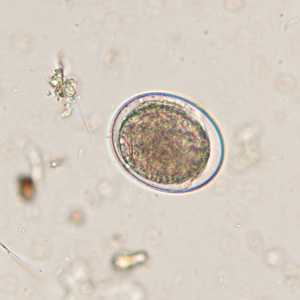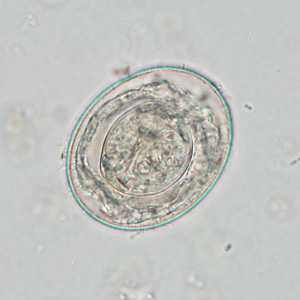
Case #425 - August 2016
Case Description
The mother of a four-year-old autistic boy found a worm in her son’s stool while changing his diaper. The family lives on a farm in rural Iowa. The worm and a stool specimen were examined by the Iowa State Hygienic Laboratory, and the images sent to the DPDx Team for confirmation/identification of one or more parasites. Figure A shows the worm next to a ruler for size; Figures B shows a composite of two images that were taken with a dissecting microscope to highlight detail. Figures C- D show objects that were observed in the stool specimen; the larger in Figure C was approximately76 micrometers and the smaller objects (Figures C and D) ranged from 45–60 micrometers. The DPDx Team requested an aliquot of the stool specimen for further testing. The objects in Figures E and F, which measured 65 and 67 micrometers respectively, show what was observed by the DPDx Team. What is your diagnosis? Based on what criteria?

Figure A

Figure B

Figure C

Figure D

Figure E

Figure F
Case Answer
This was a case of hymenolepiasis caused by Hymenolepis diminuta (the rat tapeworm). Diagnostic morphologic features shown in this case were:
- segmented worm with craspedote (overlapping) proglottids (Figures A and B)
- eggs within the size range for H. diminuta (70 – 80 micrometers) that contain an oncosphere with hooklets, but no polar filaments
It was concluded that the other objects in question were also eggs of H. diminuta in various stages of development, most likely from a ruptured proglottid. A hooklet can be seen in the egg shown in Figure E and Figure F shows a more developed oncosphere with multiple hooklets visible. Despite the atypical morphology, these eggs were still too large to be those of H. nana.
More on: hymenolepiasis
Acknowledgements
This case and images were kindly provided by the Iowa State Hygienic Laboratory Coralville, IA.
DPDx is an education resource designed for health professionals and laboratory scientists. For an overview including prevention and control visit www.cdc.gov/parasites/.
- Page last reviewed: August 24, 2016
- Page last updated: August 24, 2016
- Content source:
- Global Health – Division of Parasitic Diseases and Malaria
- Notice: Linking to a non-federal site does not constitute an endorsement by HHS, CDC or any of its employees of the sponsors or the information and products presented on the site.
- Maintained By:


 ShareCompartir
ShareCompartir